BenQ BL3201PT 32-inch Ultra HD Monitor Review
The first-generation 32-inch Ultra HD monitors came out at over $3000. They’ve dropped in price of course, but BenQ’s new BL3201PT is debuting at a more aggressive MSRP of $1100. We've even seen it selling for under $1000. Today we test its performance.
Why you can trust Tom's Hardware
Results: Grayscale Tracking And Gamma Response
Our grayscale and gamma tests are described in detail here.
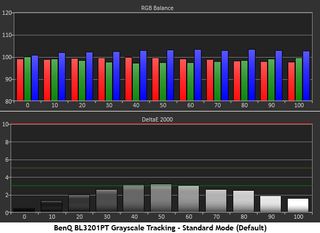
To the naked eye, there aren’t any grayscale errors in Standard mode. The chart shows a maximum DeltaE of 3.22 at 50-percent brightness. That’s only a tad over the accepted threshold of three, where grayscale errors become visible. If you don’t wish to calibrate the BL3201PT, you’ll be perfectly satisfied with its grayscale accuracy.
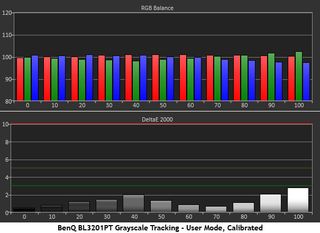
Calibrating the User mode yields a decent improvement in grayscale performance. To get 100 percent under the 3dE line, we lowered the Contrast four clicks to remove a visible green tint. Otherwise, BenQ's business-class monitor delivers excellent performance.
Here is our comparison group:
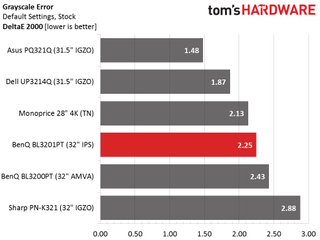
A result of 2.25dE is perfectly acceptable for an un-calibrated monitor. A majority of users will enjoy the BL3201PT’s image quality by simply adjusting brightness to taste in the Standard mode.
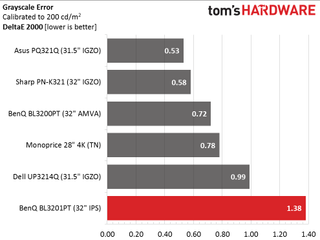
Calibration brings the average error down to 1.38dE. That's not quite as low as the rest of the group, but you won’t be able to see a difference between any of these screens without instrumented measurements. The BL3201PT doesn't perform in what we'd consider the professional class, but it's not priced like those premium products either.
Gamma Response
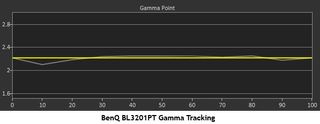
The most accurate gamma tracking is found on the number-three preset. Whether you calibrate or not, this is the tracking you’ll see. Our adjustments didn’t make a difference. Aside from the tiniest dip at 10 percent, we record a perfect result.
Here is our comparison group again:
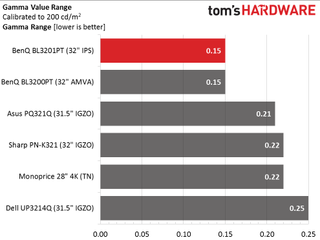
The .15 number comes from the above-mentioned dip in gamma at the 10-percent brightness level. All other values are within a whisker of 2.2.
We calculate gamma deviation by simply expressing the difference from 2.2 as a percentage.
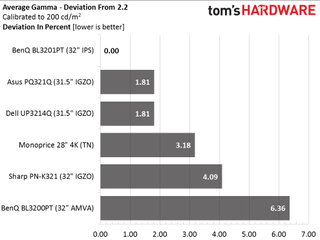
This is only the third monitor we’ve measured in the past two years displaying a perfect average gamma result of 2.2. It doesn’t get any better. Gamma this accurate easily makes up for lower contrast by providing maximum punch in all types of content.
Current page: Results: Grayscale Tracking And Gamma Response
Prev Page Results: Brightness And Contrast Next Page Results: Color Gamut And PerformanceStay On the Cutting Edge: Get the Tom's Hardware Newsletter
Get Tom's Hardware's best news and in-depth reviews, straight to your inbox.

Christian Eberle is a Contributing Editor for Tom's Hardware US. He's a veteran reviewer of A/V equipment, specializing in monitors. Christian began his obsession with tech when he built his first PC in 1991, a 286 running DOS 3.0 at a blazing 12MHz. In 2006, he undertook training from the Imaging Science Foundation in video calibration and testing and thus started a passion for precise imaging that persists to this day. He is also a professional musician with a degree from the New England Conservatory as a classical bassoonist which he used to good effect as a performer with the West Point Army Band from 1987 to 2013. He enjoys watching movies and listening to high-end audio in his custom-built home theater and can be seen riding trails near his home on a race-ready ICE VTX recumbent trike. Christian enjoys the endless summer in Florida where he lives with his wife and Chihuahua and plays with orchestras around the state.

OpenAI's new assistant makes Apple's Siri look primitive, also announces GPT-4o and new desktop PC client (Updated)

Nintendo Switch hacked to run Windows 11 on Arm, and it's just about as awful as you can imagine

Massive Dell blunder leaks Intel and Nvidia's mobile roadmaps — Nova Lake, Panther Lake CPUs and GENxx Nvidia GPUs listed
-
blackmagnum I wouldn't want to bump it over and drop it from the table, because the stand looks so tipsy.Reply -
avatar_raq I wonder why all the links to Amazon belong to the BL3201PH not the reviewed "PT" model. Am I missing something?Reply -
I Hate Nvidia I Don't Know Why monitor vendors can't make a decent 28 inch IPS UHD monitor below 500 $ whereas I bought my LG UB820T 42 inch IPS 120 Hz UHD TV for only 630$ ,and it comes with the amazing magic remote and TV tuner and smart TV support, WIFI and LAN , USB 3 and 3 HDMI 2.0 ports!Reply -
qwfgbn Dell P2415Q and P2715Q are 4K 60HZ IPS panels which can be found for around 600$ on amazon.Reply -
ohim Why is everybody stating about Luminance / Brightness as "higher is better ". I had an Iiyama 27" IPS pannel that had over 350 cd you can`t even use that monitor at 100% brightness, you can actually feel the heat from the monitor on your face. Best use was at around 25 to 50% brightness ...had to return it though due to flickering .. my eyes were going insane with that monitor.Reply -
nukemaster I hate to ask, but how is the glow?Reply
I wouldn't want to bump it over and drop it from the table, because the stand looks so tipsy.
The stand is sturdy since the 3200PT(2560 x 1440 MVA) was very solid with the same stand.
Why is everybody stating about Luminance / Brightness as "higher is better ". I had an Iiyama 27" IPS pannel that had over 350 cd you can`t even use that monitor at 100% brightness, you can actually feel the heat from the monitor on your face. Best use was at around 25 to 50% brightness ...had to return it though due to flickering .. my eyes were going insane with that monitor.
I think the brighter is better has carried over from cell phone reviews or something. Working in a very bright area could also benefit from extra brightness. On the plus side almost all BenQ screens use voltage based dimming and not PWM. This should allow you to get a dimmer screen without the flickering(not that it bothers me).
I personally have my screens at a much lower setting as well. -
Eggz Siiiick! This is the first 4K screen I've seen that seems reasonable in terms of price, performance, size, and image quality.Reply -
burmese_dude "it’s selling on the street for under $1000." I wonder if they sell these on my street. I need to call and ask.Reply -
ubercake I thought we'd start seeing some sort of adaptive sync technology on just about every monitor by now. I can't get excited about anything that doesn't have it.Reply